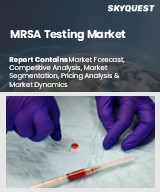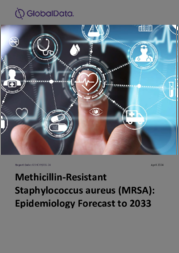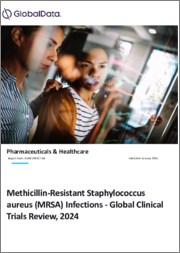
|
시장보고서
상품코드
1675301
세계의 MRSA 치료제 시장 : MRSA 유형별, 약제 클래스별, 적응 질환별, 투여 경로별, 유통 채널별, 지역별(2025-2033년)MRSA Drugs Market by MRSA Type (Hospital-Acquired, Community-Acquired ), Drug Class, Disease Indication, Route of Administration, Distribution Channel, and Region 2025-2033 |
||||||
MRSA 치료제 시장 세계 시장 규모는 2024년 39억 달러에 달했습니다. 향후 IMARC Group은 이 시장이 2033년까지 51억 달러에 달하고, 2025년부터 2033년까지 2.95%의 연평균 성장률(CAGR)을 보일 것으로 예측했습니다. 항생제 내성 박테리아의 확산, 장기 입원으로 인한 의료 시설에서 다제 내성 박테리아에 대한 지속적인 노출, 임상시험 수 증가가 시장을 주도하는 주요 요인 중 하나입니다.
메티실린 내성 황색포도상구균(MRSA)은 항생제 내성 황색포도상구균 균주에 의해 발생하는 감염으로, 일반적으로 수술, 정맥주사, 피부와 피부 접촉을 한 환자에게서 발생하며, MRSA 치료제는 메티실린 내성 황색포도상구균 감염에 대한 항균제로 사용되어 황색포도상구균을 사멸 또는 억제합니다. 병원균의 작용을 억제하는 동시에 환자의 세포 합성 및 면역력을 향상시킵니다. 가장 일반적인 MRSA 치료제는 트리메토프림-설파메톡사졸, 클린다마이신, 미노사이클린, 리네졸리드, 독시사이클린입니다. MRSA 감염은 병원이나 지역사회에서 발생할 수 있기 때문에 MRSA의 치료에는 경구약이나 정맥주사(경구약)가 사용되며, 중증도에 따라 경구약이나 정맥주사(정맥주사)가 사용될 수 있습니다. 피부 감염, 뼈 감염, 균혈증, 동물의 인수공통감염증 등 다양한 유형의 감염을 치료할 수 있는 다양한 MRSA 치료제가 있습니다.
MRSA 치료제 시장 동향 :
대중들 사이에서 항생제 내성 균주의 개발이 확산되고 있는 것은 시장 성장을 가속하는 중요한 요인입니다. 이는 전 세계적으로 병원 내 감염(HAI) 사례가 증가하고 있기 때문입니다. 또한, 장기 입원으로 인해 의료 시설에서 다제내성균에 지속적으로 노출되어 이차적인 병원 내 감염이 발생하여 시장을 촉진하고 있습니다. 여기에 더해 MRSA 감염에 취약한 노인 인구 증가는 시장에 활력을 불어넣고 있습니다. 또한, 다양한 형태의 세균 감염에 대한 인식이 높아짐에 따라 MRSA 치료제의 보급이 확대되고 있습니다. 이에 따라 많은 제품 혁신, 임상시험 증가, 신약의 도입이 시장에 유리한 성장 기회를 제공합니다. 그러나 MRSA 치료제의 신약 개발에는 높은 비용이 소요되기 때문에 시장 성장을 저해하는 요인으로 작용하고 있습니다. 반면, 다양한 진단 도구의 지속적인 기술 개발과 항생제 내성균 스크리닝을 위한 임상시험 프로그램 증가는 시장의 긍정적인 전망을 창출하고 있습니다. 또한, 주요 기업들의 광범위한 연구개발(R&D) 활동도 시장 성장에 기여하고 있습니다. 시장에 기여하는 다른 요인으로는 현재 사용 가능한 제품에 대한 제네릭 의약품의 출현, 온라인 및 오프라인의 조직화된 플랫폼에서 항생제를 쉽게 구할 수 있는 점, 급속한 도시화, 의료비 증가 등이 있습니다.
본 보고서에서 다룬 주요 질문
- 세계 MRSA 치료제 시장은 지금까지 어떻게 변화해왔고, 앞으로 어떻게 변화할 것인가?
- 세계 MRSA 치료제 시장 성장 촉진요인, 억제요인, 기회요인은 무엇인가?
- 주요 지역 시장은?
- 가장 매력적인 MRSA 치료제 시장은 어느 국가인가?
- MRSA 유형별 시장 분석은?
- 약제 유형별 시장 현황은?
- 적응증별 시장 현황은?
- 투여경로별 시장 현황은?
- 유통 채널별 시장 현황은?
- 세계 MRSA 치료제 시장 경쟁 구도는?
- 세계 MRSA 치료제 시장의 주요 기업은?
목차
제1장 서문
제2장 조사 범위와 조사 방법
- 조사 목적
- 이해관계자
- 데이터 소스
- 1차 정보
- 2차 정보
- 시장 추정
- 보텀업 접근
- 톱다운 접근
- 조사 방법
제3장 주요 요약
제4장 서론
- 개요
- 주요 업계 동향
제5장 세계의 MRSA 치료제 시장
- 시장 개요
- 시장 실적
- COVID-19의 영향
- 시장 예측
제6장 시장 분석 : MRSA 유형별
- 원내감염(HA-MRSA)
- 시중감염(CA-MRSA)
제7장 시장 분석 : 약제 클래스별
- Lipopeptides
- Oxazolidinones
- Cephalosporin
- Tetracycline
- Folate Antagonist
- 기타
제8장 시장 분석 : 적응 질환별
- 피부 감염증
- 뼈 및 관절 감염증
- 균혈증
- 동물 감염증
제9장 시장 분석 : 투여 경로별
- 경구 투여
- 비경구 투여
제10장 시장 분석 : 유통 채널별
- 병원 약국
- 소매 약국
- 온라인 약국
제11장 시장 분석 : 지역별
- 북미
- 미국
- 캐나다
- 아시아태평양
- 중국
- 일본
- 인도
- 한국
- 호주
- 인도네시아
- 기타
- 유럽
- 독일
- 프랑스
- 영국
- 이탈리아
- 스페인
- 러시아
- 기타
- 라틴아메리카
- 브라질
- 멕시코
- 기타
- 중동 및 아프리카
- 시장 분석 : 국가별
제12장 성장 촉진요인 및 억제요인, 기회
- 개요
- 성장 촉진요인
- 성장 억제요인
- 기회
제13장 밸류체인 분석
제14장 Porter의 Five Forces 분석
- 개요
- 바이어의 교섭력
- 공급 기업의 교섭력
- 경쟁 정도
- 신규 진출업체의 위협
- 대체품의 위협
제15장 가격 분석
제16장 경쟁 구도
- 시장 구조
- 주요 기업
- 주요 기업 개요
- AbbVie Inc.
- Basilea Pharmaceutica Ltd
- Crystal Genomics Inc.
- Cumberland Pharmaceuticals Inc
- Melinta Therapeutics Inc
- Paratek Pharmaceuticals, Inc.
- Pfizer Inc
The global MRSA drugs market size reached USD 3.9 Billion in 2024. Looking forward, IMARC Group expects the market to reach USD 5.1 Billion by 2033, exhibiting a growth rate (CAGR) of 2.95% during 2025-2033. The rising prevalence of antibiotic resistant strains development, continual exposure to multidrug-resistant organisms in healthcare facilities due to prolonged hospital admission and the growing number of clinical trials represent some of the key factors driving the market.
Methicillin-resistant staphylococcus aureus (MRSA) is an infection caused by antibiotic-resistant strains of staphylococcus aureus that generally occurs in patients who undergo surgical procedures, receive intravenous tubing, or come in contact with each other skin-to-skin. The MRSA drugs are used as antimicrobial agents against methicillin-resistant staphylococcus aureus infection in order to kill or restrain it. They inhibit the actions of pathogens while enhancing the patient's cellular synthesis and immunity. The most common MRSA drugs consist of trimethoprim-sulfamethoxazole, clindamycin, minocycline, linezolid, or doxycycline. These drugs are generally used as oral medication, usually on a course of seven to ten days. MRSA infections can arise from hospitals or from community, hence the treatment for MRSA can sometimes involve the administration of oral medications and intravenous (IV) medications, depending on the severity. There are a wide variety of MRSA drugs available that can be used for the treatment of different types of infections, including skin infections, bone infections, bacteremia, and even zoonotic infections in animals.
MRSA Drugs Market Trends:
The rising prevalence of antibiotic resistant strains development among the masses is a significant factor driving the growth of the market. This can be attributed to the increase in the number of cases of hospital-acquired infections (HAIs) on the global level. Also, the continual exposure to multidrug-resistant organisms in healthcare facilities due to prolonged hospital admission is resulting in the development of secondary nosocomial infections, thereby propelling the market. In addition to this, the growing geriatric population that is more susceptible to developing MRSA infections is providing an impetus to the market. Moreover, the augmenting awareness regarding different forms of bacterial infection is leading to a higher uptake of MRSA drugs. In line with this, numerous product innovations, growing number of clinical trials and the introduction of novel drug variants are creating lucrative growth opportunities in the market. However, the high costs involved in developing novel MRSA drug variants is acting as major growth restraining-factor for the market. On the contrary, continual technological developments in various diagnostic tools, along with the increasing number of clinical trial programs for the screening of antibiotic resistant strains of bacteria, are creating a positive market outlook. The market is further impelled by extensive research and development (R&D) activities conducted by the key players. Some of the other factors contributing to the market include the emergence of generic drugs against presently available products, easy availability of antibiotics across online and offline organized platforms, rapid urbanization, and increasing medical expenditure.
Key Market Segmentation:
MRSA Type Insights
- Hospital-Acquired (HA-MRSA)
- Community-Acquired (CA-MRSA)
Drug Class Insights
- Lipopeptides
- Oxazolidinones
- Cephalosporin
- Tetracycline
- Folate Antagonist
- Others
Disease Indication Insights
- Skin Infections
- Bone and Joint Infections
- Bacteremia
- Animal Infections
Route of Administration Insights
- Oral Administration
- Parenteral Administration
Distribution Channel Insights
- Hospital Pharmacies
- Retail Pharmacies
- Online Pharmacies
Regional Insights:
- North America
- United States
- Canada
- Asia Pacific
- China
- Japan
- India
- South Korea
- Australia
- Indonesia
- Others
- Europe
- Germany
- France
- United Kingdom
- Italy
- Spain
- Russia
- Others
- Latin America
- Brazil
- Mexico
- Others
- Middle East and Africa
- The report has also provided a comprehensive analysis of all the major regional markets that include North America (the United States and Canada); Asia Pacific (China, Japan, India, South Korea, Australia, Indonesia, and others); Europe (Germany, France, the United Kingdom, Italy, Spain, Russia, and others); Latin America (Brazil, Mexico, and others); and Middle East and Africa. According to the report, North America was the largest market for MRSA drugs. Some of the factors driving the North America MRSA drugs market include the rising medical expenditure, the increasing number of clinical trial programs, extensive research and development (R&D) activities conducted by key players, etc.
- Competitive Landscape
- The report has also provided a comprehensive analysis of the competitive landscape in the global MRSA drugs market. Detailed profiles of all major companies have also been provided. Some of the companies covered include AbbVie Inc., Basilea Pharmaceutica Ltd, Crystal Genomics Inc., Cumberland Pharmaceuticals Inc., Melinta Therapeutics Inc, Paratek Pharmaceuticals, Inc., Pfizer Inc, etc.
Key Questions Answered in This Report:
- How has the global MRSA drugs market performed so far and how will it perform in the coming years?
- What are the drivers, restraints, and opportunities in the global MRSA drugs market?
- What are the key regional markets?
- Which countries represent the most attractive MRSA drugs markets?
- What is the breakup of the market based on the MRSA type?
- What is the breakup of the market based on the drug class?
- What is the breakup of the market based on the disease indication?
- What is the breakup of the market based on the route of administration?
- What is the breakup of the market based on the distribution channel?
- What is the competitive structure of the global MRSA drugs market?
- Who are the key players/companies in the global MRSA drugs market?
Table of Contents
1 Preface
2 Scope and Methodology
- 2.1 Objectives of the Study
- 2.2 Stakeholders
- 2.3 Data Sources
- 2.3.1 Primary Sources
- 2.3.2 Secondary Sources
- 2.4 Market Estimation
- 2.4.1 Bottom-Up Approach
- 2.4.2 Top-Down Approach
- 2.5 Forecasting Methodology
3 Executive Summary
4 Introduction
- 4.1 Overview
- 4.2 Key Industry Trends
5 Global MRSA Drugs Market
- 5.1 Market Overview
- 5.2 Market Performance
- 5.3 Impact of COVID-19
- 5.4 Market Forecast
6 Market Breakup by MRSA Type
- 6.1 Hospital-Acquired (HA-MRSA)
- 6.1.1 Market Trends
- 6.1.2 Market Forecast
- 6.2 Community-Acquired (CA-MRSA)
- 6.2.1 Market Trends
- 6.2.2 Market Forecast
7 Market Breakup by Drug Class
- 7.1 Lipopeptides
- 7.1.1 Market Trends
- 7.1.2 Market Forecast
- 7.2 Oxazolidinones
- 7.2.1 Market Trends
- 7.2.2 Market Forecast
- 7.3 Cephalosporin
- 7.3.1 Market Trends
- 7.3.2 Market Forecast
- 7.4 Tetracycline
- 7.4.1 Market Trends
- 7.4.2 Market Forecast
- 7.5 Folate Antagonist
- 7.5.1 Market Trends
- 7.5.2 Market Forecast
- 7.6 Others
- 7.6.1 Market Trends
- 7.6.2 Market Forecast
8 Market Breakup by Disease Indication
- 8.1 Skin Infections
- 8.1.1 Market Trends
- 8.1.2 Market Forecast
- 8.2 Bone and Joint Infections
- 8.2.1 Market Trends
- 8.2.2 Market Forecast
- 8.3 Bacteremia
- 8.3.1 Market Trends
- 8.3.2 Market Forecast
- 8.4 Animal Infections
- 8.4.1 Market Trends
- 8.4.2 Market Forecast
9 Market Breakup by Route of Administration
- 9.1 Oral Administration
- 9.1.1 Market Trends
- 9.1.2 Market Forecast
- 9.2 Parenteral Administration
- 9.2.1 Market Trends
- 9.2.2 Market Forecast
10 Market Breakup by Distribution Channel
- 10.1 Hospital Pharmacies
- 10.1.1 Market Trends
- 10.1.2 Market Forecast
- 10.2 Retail Pharmacies
- 10.2.1 Market Trends
- 10.2.2 Market Forecast
- 10.3 Online Pharmacies
- 10.3.1 Market Trends
- 10.3.2 Market Forecast
11 Market Breakup by Region
- 11.1 North America
- 11.1.1 United States
- 11.1.1.1 Market Trends
- 11.1.1.2 Market Forecast
- 11.1.2 Canada
- 11.1.2.1 Market Trends
- 11.1.2.2 Market Forecast
- 11.1.1 United States
- 11.2 Asia-Pacific
- 11.2.1 China
- 11.2.1.1 Market Trends
- 11.2.1.2 Market Forecast
- 11.2.2 Japan
- 11.2.2.1 Market Trends
- 11.2.2.2 Market Forecast
- 11.2.3 India
- 11.2.3.1 Market Trends
- 11.2.3.2 Market Forecast
- 11.2.4 South Korea
- 11.2.4.1 Market Trends
- 11.2.4.2 Market Forecast
- 11.2.5 Australia
- 11.2.5.1 Market Trends
- 11.2.5.2 Market Forecast
- 11.2.6 Indonesia
- 11.2.6.1 Market Trends
- 11.2.6.2 Market Forecast
- 11.2.7 Others
- 11.2.7.1 Market Trends
- 11.2.7.2 Market Forecast
- 11.2.1 China
- 11.3 Europe
- 11.3.1 Germany
- 11.3.1.1 Market Trends
- 11.3.1.2 Market Forecast
- 11.3.2 France
- 11.3.2.1 Market Trends
- 11.3.2.2 Market Forecast
- 11.3.3 United Kingdom
- 11.3.3.1 Market Trends
- 11.3.3.2 Market Forecast
- 11.3.4 Italy
- 11.3.4.1 Market Trends
- 11.3.4.2 Market Forecast
- 11.3.5 Spain
- 11.3.5.1 Market Trends
- 11.3.5.2 Market Forecast
- 11.3.6 Russia
- 11.3.6.1 Market Trends
- 11.3.6.2 Market Forecast
- 11.3.7 Others
- 11.3.7.1 Market Trends
- 11.3.7.2 Market Forecast
- 11.3.1 Germany
- 11.4 Latin America
- 11.4.1 Brazil
- 11.4.1.1 Market Trends
- 11.4.1.2 Market Forecast
- 11.4.2 Mexico
- 11.4.2.1 Market Trends
- 11.4.2.2 Market Forecast
- 11.4.3 Others
- 11.4.3.1 Market Trends
- 11.4.3.2 Market Forecast
- 11.4.1 Brazil
- 11.5 Middle East and Africa
- 11.5.1 Market Trends
- 11.5.2 Market Breakup by Country
- 11.5.3 Market Forecast
12 Drivers, Restraints, and Opportunities
- 12.1 Overview
- 12.2 Drivers
- 12.3 Restraints
- 12.4 Opportunities
13 Value Chain Analysis
14 Porters Five Forces Analysis
- 14.1 Overview
- 14.2 Bargaining Power of Buyers
- 14.3 Bargaining Power of Suppliers
- 14.4 Degree of Competition
- 14.5 Threat of New Entrants
- 14.6 Threat of Substitutes
15 Price Analysis
16 Competitive Landscape
- 16.1 Market Structure
- 16.2 Key Players
- 16.3 Profiles of Key Players
- 16.3.1 AbbVie Inc.
- 16.3.1.1 Company Overview
- 16.3.1.2 Product Portfolio
- 16.3.1.3 Financials
- 16.3.1.4 SWOT Analysis
- 16.3.2 Basilea Pharmaceutica Ltd
- 16.3.2.1 Company Overview
- 16.3.2.2 Product Portfolio
- 16.3.3 Crystal Genomics Inc.
- 16.3.3.1 Company Overview
- 16.3.3.2 Product Portfolio
- 16.3.3.3 Financials
- 16.3.4 Cumberland Pharmaceuticals Inc
- 16.3.4.1 Company Overview
- 16.3.4.2 Product Portfolio
- 16.3.4.3 Financials
- 16.3.5 Melinta Therapeutics Inc
- 16.3.5.1 Company Overview
- 16.3.5.2 Product Portfolio
- 16.3.5.3 Financials
- 16.3.6 Paratek Pharmaceuticals, Inc.
- 16.3.6.1 Company Overview
- 16.3.6.2 Product Portfolio
- 16.3.6.3 Financials
- 16.3.6.4 SWOT Analysis
- 16.3.7 Pfizer Inc
- 16.3.7.1 Company Overview
- 16.3.7.2 Product Portfolio
- 16.3.7.3 Financials
- 16.3.7.4 SWOT Analysis
- 16.3.1 AbbVie Inc.
Kindly note that this only represents a partial list of companies, and the complete list has been provided in the report.



















